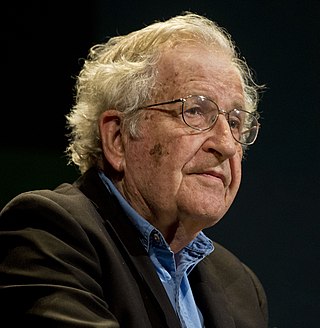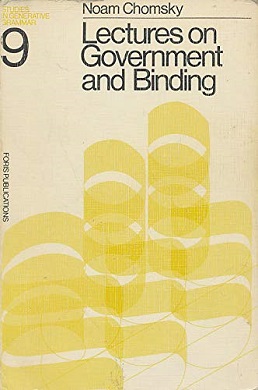
Universal grammar (UG), in modern linguistics, is the theory of the innate biological component of the language faculty, usually credited to Noam Chomsky. The basic postulate of UG is that there are innate constraints on what the grammar of a possible human language could be. When linguistic stimuli are received in the course of language acquisition, children then adopt specific syntactic rules that conform to UG. The advocates of this theory emphasize and partially rely on the poverty of the stimulus (POS) argument and the existence of some universal properties of natural human languages. However, the latter has not been firmly established, as some linguists have argued languages are so diverse that such universality is rare, and the theory of universal grammar remains controversial among linguists.
In linguistics, transformational grammar (TG) or transformational-generative grammar (TGG) is part of the theory of generative grammar, especially of natural languages. It considers grammar to be a system of rules that generate exactly those combinations of words that form grammatical sentences in a given language and involves the use of defined operations to produce new sentences from existing ones.

Generative grammar, or generativism, is a linguistic theory that regards linguistics as the study of a hypothesised innate grammatical structure. It is a biological or biologistic modification of earlier structuralist theories of linguistics, deriving from logical syntax and glossematics. Generative grammar considers grammar as a system of rules that generates exactly those combinations of words that form grammatical sentences in a given language. It is a system of explicit rules that may apply repeatedly to generate an indefinite number of sentences which can be as long as one wants them to be. The difference from structural and functional models is that the object is base-generated within the verb phrase in generative grammar. This purportedly cognitive structure is thought of as being a part of a universal grammar, a syntactic structure which is caused by a genetic mutation in humans.
In linguistics, the minimalist program is a major line of inquiry that has been developing inside generative grammar since the early 1990s, starting with a 1993 paper by Noam Chomsky.
In the philosophy of mind, innatism is the view that the mind is born with already-formed ideas, knowledge, and beliefs. The opposing doctrine, that the mind is a tabula rasa at birth and all knowledge is gained from experience and the senses, is called empiricism.
An interlanguage is an idiolect which has been developed by a learner of a second language (L2) which preserves some features of their first language (L1) and can overgeneralize some L2 writing and speaking rules. These two characteristics give an interlanguage its unique linguistic organization. It is idiosyncratically based on the learner's experiences with L2. An interlanguage can fossilize, or cease developing, in any of its developmental stages. It is claimed that several factors shape interlanguage rules, including L1 transfer, previous learning strategies, strategies of L2 acquisition, L2 communication strategies, and the overgeneralization of L2 language patterns.
The Language Acquisition Device (LAD) is a claim from language acquisition research proposed by Noam Chomsky in the 1960s. The LAD concept is a purported instinctive mental capacity which enables an infant to acquire and produce language. It is a component of the nativist theory of language. This theory asserts that humans are born with the instinct or "innate facility" for acquiring language. The main argument given in favor of the LAD was the argument from the poverty of the stimulus, which argues that unless children have significant innate knowledge of grammar, they would not be able to learn language as quickly as they do, given that they never have access to negative evidence and rarely receive direct instruction in their first language.
In linguistics and social sciences, markedness is the state of standing out as nontypical or divergent as opposed to regular or common. In a marked–unmarked relation, one term of an opposition is the broader, dominant one. The dominant default or minimum-effort form is known as unmarked; the other, secondary one is marked. In other words, markedness involves the characterization of a "normal" linguistic unit against one or more of its possible "irregular" forms.
Poverty of the stimulus (POS) is the controversial argument from linguistics that children are not exposed to rich enough data within their linguistic environments to acquire every feature of their language. This is considered evidence contrary to the empiricist idea that language is learned solely through experience. The claim is that the sentences children hear while learning a language do not contain the information needed to develop a thorough understanding of the grammar of the language.
In the field of psychology, nativism is the view that certain skills or abilities are "native" or hard-wired into the brain at birth. This is in contrast to the "blank slate" or tabula rasa view, which states that the brain has inborn capabilities for learning from the environment but does not contain content such as innate beliefs. This factor contributes to the ongoing nature versus nurture dispute, one borne from the current difficulty of reverse engineering the subconscious operations of the brain, especially the human brain.

The term Cartesian linguistics was coined by Noam Chomsky in his book Cartesian Linguistics: A Chapter in the History of Rationalist Thought (1966). The adjective "Cartesian" pertains to René Descartes, a prominent 17th-century philosopher. As well as Descartes, Chomsky surveys other examples of rationalist thought in 17th-century linguistics, in particular the Port-Royal Grammar (1660), which foreshadows some of his own ideas concerning universal grammar.

Plato's problem is the term given by Noam Chomsky to "the problem of explaining how we can know so much" given our limited experience. Chomsky believes that Plato asked how we should account for the rich, intrinsic, common structure of human cognition, when it seems underdetermined by extrinsic evidence presented to a person during human development. In linguistics this is referred to as the "argument from poverty of the stimulus" (APS). Such arguments are common in the natural sciences, where a developing theory is always "underdetermined by evidence". Chomsky's approach to Plato's problem involves treating cognition as a normal research topic in the natural sciences, so cognition can be studied to elucidate intertwined genetic, developmental, and biophysical factors. Plato's problem is most clearly illustrated in the Meno dialogue, in which Socrates demonstrates that an uneducated boy nevertheless understands geometric principles.
The generative approach to second language (L2) acquisition (SLA) is a cognitive based theory of SLA that applies theoretical insights developed from within generative linguistics to investigate how second languages and dialects are acquired and lost by individuals learning naturalistically or with formal instruction in foreign, second language and lingua franca settings. Central to generative linguistics is the concept of Universal Grammar (UG), a part of an innate, biologically endowed language faculty which refers to knowledge alleged to be common to all human languages. UG includes both invariant principles as well as parameters that allow for variation which place limitations on the form and operations of grammar. Subsequently, research within the Generative Second-Language Acquisition (GenSLA) tradition describes and explains SLA by probing the interplay between Universal Grammar, knowledge of one's native language and input from the target language. Research is conducted in syntax, phonology, morphology, phonetics, semantics, and has some relevant applications to pragmatics.
The critical period hypothesis or sensitive period hypothesis claims that there is an ideal time window of brain development to acquire language in a linguistically rich environment, after which further language acquisition becomes much more difficult and effortful. It is the subject of a long-standing debate in linguistics and language acquisition over the extent to which the ability to acquire language is biologically linked to age. The critical period hypothesis was first proposed by Montreal neurologist Wilder Penfield and co-author Lamar Roberts in their 1959 book Speech and Brain Mechanisms, and was popularized by Eric Lenneberg in 1967 with Biological Foundations of Language.
In linguistics, the innateness hypothesis, also known as the nativist hypothesis, holds that humans are born with at least some knowledge of linguistic structure. On this hypothesis, language acquisition involves filling in the details of an innate blueprint rather than being an entirely inductive process. The hypothesis is one of the cornerstones of generative grammar and related approaches in linguistics. Arguments in favour include the poverty of the stimulus, the universality of language acquisition, as well as experimental studies on learning and learnability. However, these arguments have been criticized, and the hypothesis is widely rejected in other traditions such as usage-based linguistics. The term was coined by Hilary Putnam in reference to the views of Noam Chomsky.
Nina Hyams is a distinguished research professor emeritus in linguistics at the University of California in Los Angeles.

Lectures on Government and Binding: The Pisa Lectures (LGB) is a book by the linguist Noam Chomsky, published in 1981. It is based on the lectures Chomsky gave at the GLOW conference and workshop held at the Scuola Normale Superiore in Pisa, Italy, in 1979. In this book, Chomsky presented his government and binding theory of syntax. It had great influence on the syntactic research in early 1980s, especially among the linguists working within the transformational grammar framework.
Vivian James Cook was a British linguist who was Emeritus Professor of Applied Linguistics at Newcastle University. He was known for his work on second-language acquisition and second-language teaching, and for writing textbooks and popular books about linguistics. He worked on a number of topics such as bilingualism, EFL, first-language acquisition, second-language teaching, linguistics, and the English writing system. He published more than 20 books and 100 papers. He was founder and first President of the European Second Language Association (EuroSLA), and co-founder of the Oxford University Press journal Writing Systems Research. He died in December 2021, at the age of 81.
The main purpose of theories of second-language acquisition (SLA) is to shed light on how people who already know one language learn a second language. The field of second-language acquisition involves various contributions, such as linguistics, sociolinguistics, psychology, cognitive science, neuroscience, and education. These multiple fields in second-language acquisition can be grouped as four major research strands: (a) linguistic dimensions of SLA, (b) cognitive dimensions of SLA, (c) socio-cultural dimensions of SLA, and (d) instructional dimensions of SLA. While the orientation of each research strand is distinct, they are in common in that they can guide us to find helpful condition to facilitate successful language learning. Acknowledging the contributions of each perspective and the interdisciplinarity between each field, more and more second language researchers are now trying to have a bigger lens on examining the complexities of second language acquisition.
Subjacency is a general syntactic locality constraint on movement. It specifies restrictions placed on movement and regards it as a strictly local process. This term was first defined by Noam Chomsky in 1973 and constitutes the main concept of the Government and Binding Theory. The revised definition of subjacency from Chomsky (1977) is as follows: "A cyclic rule cannot move a phrase from position Y to position X in … X … [α… [β… Y … ] … ] … X …, where α and β are cyclic nodes. Cyclic nodes are S and NP",.





